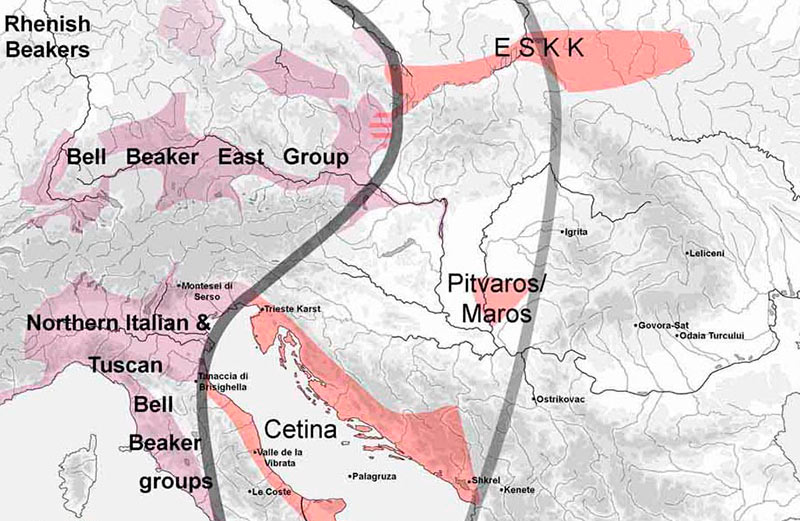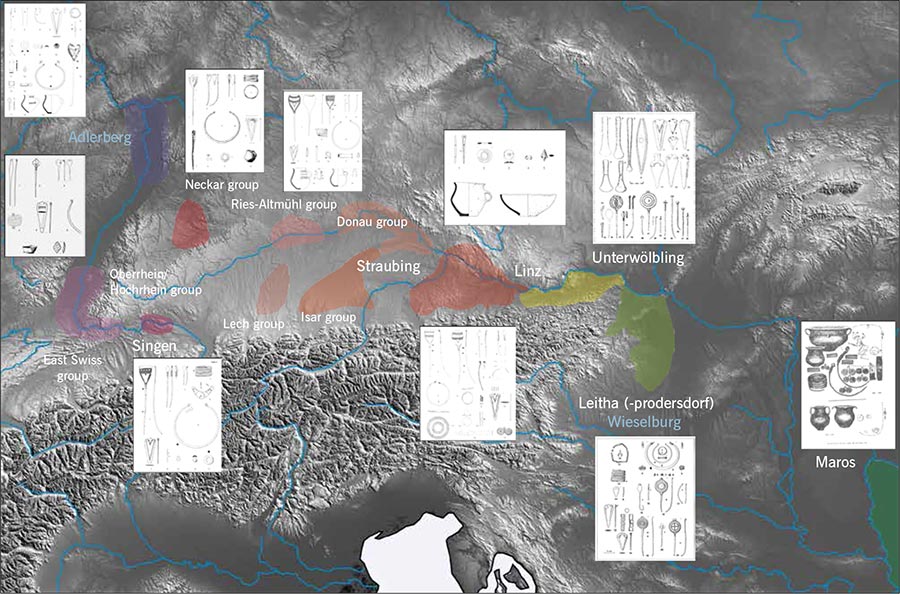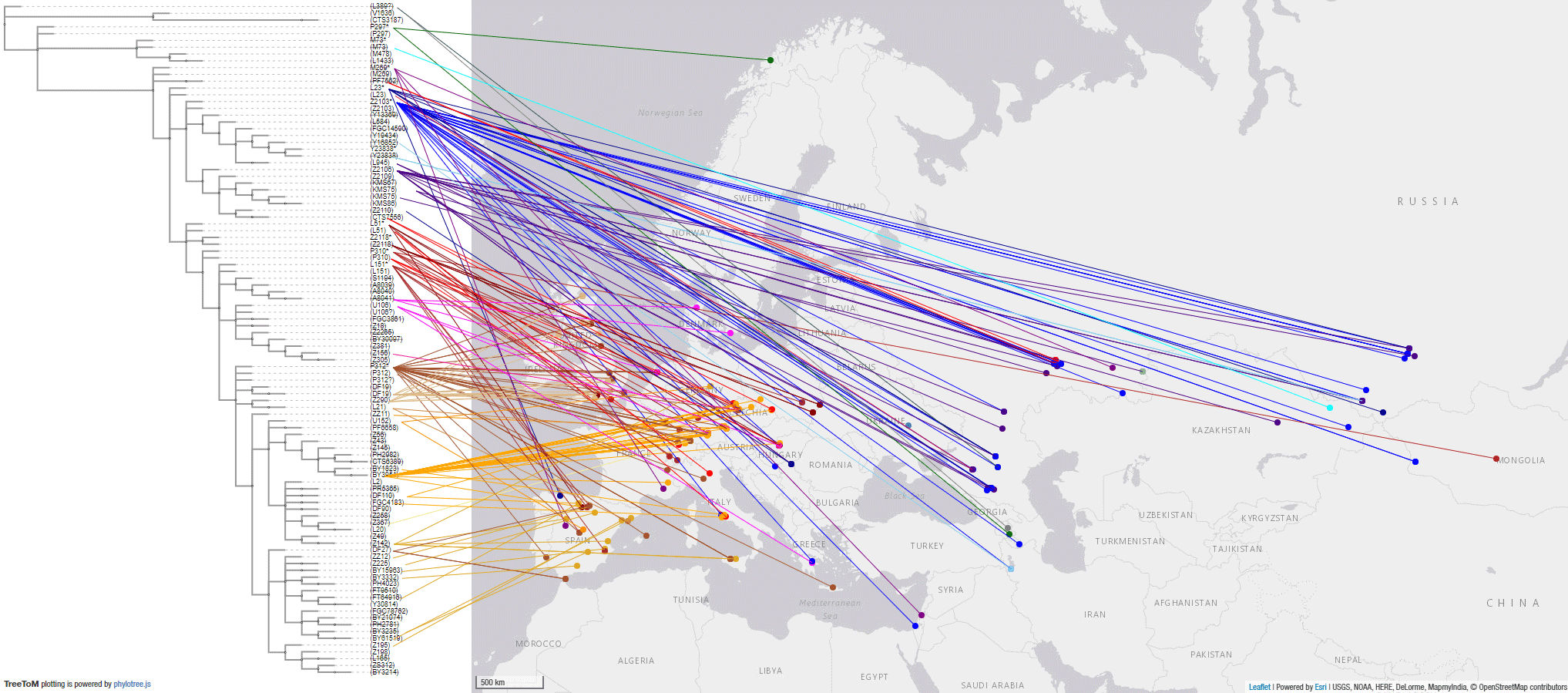New preprint Kinship, acquired and inherited status, and population structure at the Early Bronze Age Mokrin necropolis in northern Serbia, by Zegarac et al. bioRxiv (2020).
Intersesting excerpts about this 2100-1800 BC cemetery (emphasis mine):
Ancestry
The individual Mokrin genomes are best modelled as a mixture of Central European hunter-gatherers, Aegean Neolithic farmers and influences from the Eastern European steppes (mean qpAdm tail probability individually 0.46, pooled 0.08).
We observed no significant variation in the eastern European steppe-like component between individuals. Pooling individuals, admixture proportions are estimated to be around 8% (± 1.2% SE) western hunter gatherers, 55% (± 2.5% SE) Aegean Neolithic farmers, and 37% (± 2.3% SE) Eastern European steppe-like population. Quantification of shared drift to other temporally and geographically close ancient individuals via outgroup f3 statistics did not reveal any particularly close affinities, reflecting the genetic homogenization of Europe during the Bronze Age.

Patterns of status transmission
Although the differences in status within the Mokrin necropolis were not extreme, there was great variability in grave goods displayed by biological relatives.
There were only two cases in which relatives expressed similar social status through their grave goods: the two men in burials 220 (15-25 years old) and 225 (25-35 years old) were second degree relatives and were both buried without grave goods.
At the opposite end of the status spectrum, a woman from the burial 181 was very likely the mother of the male in burial 163 and both were buried with grave goods indicative of higher social status. Since the male individual was an adult at the time of death, it remains unclear whether he inherited or acquired his status.

Interestingly, the three R1b-Z2103 samples seem to be closely related, and the three relationships displayed in the burials can be connected to the Indo-European family system (avuncular and grandparent-grandchild), whereas the half-sibling nature of two of them – one of them female, not sharing mtDNA – supports the existence of EBA bottlenecks due to paternally-related offspring.
The high status of an individual of hg. J2b – likely J2b-L283, a lineage of Balkan/Central Mediterranean Neolithic distribution – as well as other high status burials, together with the lower status* of Yamnaya/Bell Beaker derived R1b-Z2103 (barring potentially sample 243, the nephew of 257B through his mother 257A) points to the increasing relevance of local lineages during the EBA in detriment of the likely ‘original’ Yamnaya/East Bell Beaker-derived patrilineally-related community of the earliest stage of the Maros group.
* While rich status is a clear feature of some burials and not others, I don’t think it is the most straightforward solution to assume (as the authors do) that this small sampling of a single cemetery could “discover” the surprising origin of a radical generational change (from lower to higher status) in not only one but two cases: female 181 to male 163, and female 257A to male 223. It seems much more likely that here is something else going on in the male vs. female burial system.
Perjámos-Maros
The likely origin of the Maros culture / EBA group population was recently described by Bertemes & Heyd (2015):
(…) the beginnings of the east-Austrian Leitha and Unterwölbling groups (and the Early Maros Culture) must be set one or two generations earlier than the beginning of the Straubing group, for example. In turn, the novelties defining the Danubian EBA arrive in Singen and central Switzerland a further one or two generations later than in Straubing.
Due to its distribution over three countries (Hungary, Romania, Serbia), its long duration of c. 500 years, and the early discovery of both graves and settlement sites, this culture/group is known by several terms and names, such as Perjámos, Periam, and Maros/Mures¸, and is sometimes combined with the neighbouring so-called Ada group. In order to avoid further confusion, we will refer to it as the “Early Maros Culture”.
(…) there is, in the cultural entity of the Early Maros Culture, a kind of regional exclave of the Danubian EBA in south-eastern Hungary/ south-western Romania/northern Serbia, far outside its core area north of the Alps. The arrangement of the cemeteries, the burials and burial customs, and the material culture found at sites such as Sándorfalva-Eperjes, co. Csongrád (Hungary; Trogmayer 2001) and Kiskundorozsma-Hosszúhát-halom near Szeged, co. Csongrád (Hungary; Bende/ Lörinczy 2002), complemented by the earliest graves in the cemetery of Mokrin (Wagner 2009), are in the initial phases so interchangeable with those of the Burgenland and Lower Austria (already recognised by Fischl/Kulcsár 2o11) that one starts to wonder how this can possibly be so. It is all the more astonishing since these cemeteries start suddenly, without any regional predecessors. Likewise, there are no similar cemeteries and isolated burials in the several hundred kilometres in-between, in territory which is occupied by a different EBA complex, the Nagyrév group (Vollmann 2005).
Finally, no real Bell Beaker substrate in this part of Hungary/Romania, beyond some isolated finds (Heyd 2oo7a; Dani/Tóth 2014), has ever been documented. This leaves us with only one realistic assumption: that prehistoric peoples, probably of a Leitha and/or Unterwölbling group background, emigrated along the Danube River to the south and settled here in a foreign territory, probably at the time of the initial Danubian EBA. But why this migration took place around 2200 BC remains totally unknown. Was it due to demographic pressure? Was it due to a subsistence crisis? Or were these even refugees from the communities of the Bell Beaker cemeteries around Budapest, whose settlement sites soon after became part of the Nagyrév group (Endrödi 2014, 270–272)? We don’t have answers yet but better data on the why and how could surely be provided by bio-archaeological investigations which have not yet been undertaken.

Of a similar opinion about migration waves are Marková and Ilion (2013):
Although the population lived mostly on the same territory as the Beba Veche/Óbéba-Pitvaros culture, it gave rise to its own new settlements. Usually they were tells, where huge layers were formed (e.g. Periam/Perjámos, Pecica/Pécska, Klárafalva). Post-built houses (6–8 by 4–5 m) with floor and hearth were arranged in narrow lanes. A range of metal artefacts were created, for example Rollenkopfnadeln, Hülsenkopfnadeln, neckrings, triangular short daggers at first; later tutuli, crescentic and heart-shaped pendants; and finally flat axes, long daggers, spearheads, Ţufalău-type axes, hammer-axes of Gaura and Křtenov types. Beads of faience and amber are also present, indicating a wide range of long-distance contacts. The burial rite consists of skeletons in crouched or sitting position, with the appearance of pithos burials as well. Social differences are observable from the third phase. In Hungary the sites at Szőreg, Deszk, and Battonya are important (Bóna 1975).
The emergence of even more R1b-Z2103 lineages among East Bell Beaker-derived groups from the Middle to Upper Danube (among samples within a cluster described as ‘northern’ and ‘upper’ in the PCA) should come as no surprise by now, given the already available early East Bell Beakers from Poland and Hungary (one of them, Sfu3, packing the highest Yamnaya ancestry among Bell Beakers), and especially in this highly conservative cultural region around the Danube – with their strong attachment to tradition also visible in the strict patrilineal family ties through their prevailing Yamnaya lineages. The wide current distribution (see YFull) of the reported R1b-CTS7556 subclade (the other two are reported as upstream Z2108) confirms that this lineage formed part of early East Bell Beakers.

Its direct cultural connection to the conservative Danubian Early Bronze Age and the presence of other South-East European lineages in this necropolis (such as I2 and the already published G2a-Z6484 in Mathieson 2015*), as well as the evidence of R1b-Z2103 and archaic R1b-L51 lineages among Italic peoples (and probably also among Palaeo-Balkan-speaking peoples) confirms that the tens of thousands of late Yamnaya / Proto-East Bell Beakers from the Hungarian Plains were both a sink of West Yamnaya R1b-L23 (R1b-Z2103 and R1b-L51) lineages, but also – after centuries of local admixture – a source of the different East BBC bottlenecks, such as those under R1b-L151 visible among Bell Beaker and derived groups of Western and Northern Europe.
* Haplogroup G2 is clearly related to Southern European Final Neolithic groups, and is continued among early Bell Beakers and derived Steppe-related EBA populations: see e.g. the recent samples showing Steppe admixture among Switzerland BBC, Hungary BBC, Lech Valley BBC/EBA, or the findings of Steppe ancestry and hg. G2a in Polada EBA in the recent thesis by Graeffen 2020. The lack of precise SNP calls postdating the Late Neolithic period in most cases hinders a proper evaluation of which ones might have been part of the admixed Late Yamnaya/Proto-East BBC community (with a likely origin in Hungary Baden LCA), and which ones represent local admixture and/or resurgence events instead.
See also
- Early arrival of Steppe ancestry in Switzerland
- Yamnaya ancestry: mapping the Proto-Indo-European expansions
- Italo-Venetic peoples related patrilineally to Terramare elites
- Corded Ware and Bell Beaker related groups defined by patrilocality and female exogamy
- R1b-L23-rich Bell Beaker-derived Italic peoples from the West vs. Etruscans from the East
- Bell Beakers and Mycenaeans from Yamnaya; Corded Ware from the forest steppe
- East Bell Beakers, an in situ admixture of Yamna settlers and GAC-like groups in Hungary
- Yamnaya replaced Europeans, but admixed heavily as they spread to Asia